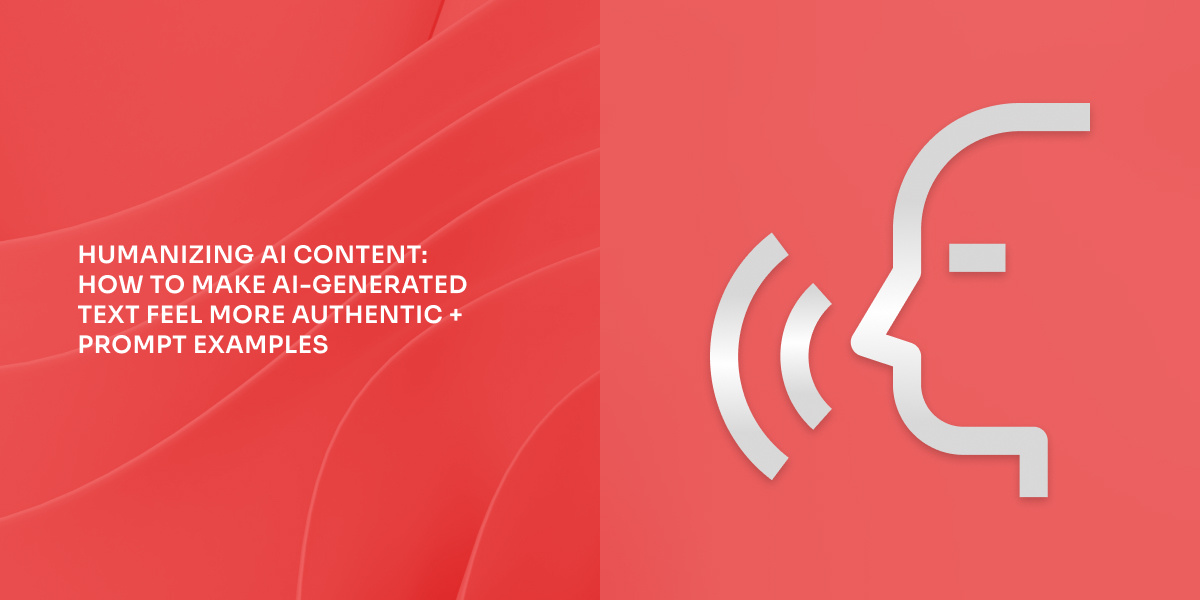Humanizing AI content: how to make AI-generated text feel more authentic + prompt examples

A marketing strategist with a background in philosophy, Ara is the Coordinator for Marketing at WriteText.ai and 1902 Software. With seven years of experience in B2B marketing, she is deeply interested in AI and its impact on marketing and product development. As part of the core team at WriteText.ai, she helps bridge the gap between technology and strategy, making AI-powered solutions more accessible to businesses.

Introduction
What is AI content?
AI content refers to digital media like text, images, or videos generated by artificial intelligence tools. These tools use algorithms and machine learning to create content based on the data or prompts you give them. In recent years, AI-generated content has gained significant popularity across various industries, including:
- Ecommerce. AI is used to craft product descriptions, customer emails, and reviews, saving time and improving efficiency.
- Marketing. Marketers rely on AI to generate blog posts, social media updates, and ad copy, streamlining their workflows.
- Media. News outlets are using AI to produce articles, summaries, and reports faster than ever before.
While AI content creation is highly efficient, it can sometimes feel robotic or lack emotional connection. Even though AI can produce content quickly, it often misses the nuances that human writers naturally include.
Why humanizing AI content is important
To truly engage your audience, your content needs to feel relatable and authentic. AI does an excellent job at mimicking human language, but it sometimes struggles to convey emotions and personal connections. Here are some common issues with AI-generated content:
- Lack of emotional connection. AI-driven content often focuses on facts or data, leaving out the personal touch that creates empathy.
- Overly polished language. AI’s precision can sometimes make content feel unnatural, like it’s too perfect.
- Inconsistent tone. AI may have trouble maintaining a consistent voice throughout a piece, leading to a disconnected reading experience.
Key strategies to humanize AI content
1. Maintain a conversational tone
Using a conversational tone helps make content feel approachable and personal. When AI-generated text sounds too formal, it can create distance between the content and the reader. A more casual, conversational style encourages readers to engage with your content as if they’re having a chat with a friend.
Tips for creating a conversational tone:
- Use contractions like “you’re” instead of “you are.”
- Stick to simple language and short, clear sentences.
- Avoid technical jargon unless it’s necessary for your audience.
- Review AI-generated content and adjust phrases to sound more natural.
ChatGPT prompt example: "Write a product description for a coffee maker in a casual, friendly tone, as if explaining it to a friend."
2. Infuse personal anecdotes and storytelling
Stories are a powerful way to captivate your audience and make your content more memorable. While AI can generate informative content, it often lacks the storytelling quality that keeps readers engaged. Adding personal anecdotes or hypothetical examples can provide that missing emotional element.
How to integrate personal stories into AI content:
- Share real-life experiences or case studies to add depth.
- Use hypothetical scenarios that resonate with your audience’s challenges or needs.
- Look for areas in the AI-generated text where a story could enhance the message and make the content more relatable.
ChatGPT prompt example: "Generate a blog post introduction about time management with a personal anecdote about struggling to balance work and family life."
3. Prioritize clarity and readability
Clear and concise content is essential for keeping your readers’ attention. AI-generated content can sometimes result in awkward phrasing or overly complex language, which can confuse or frustrate your audience. Ensuring that the content flows smoothly will help readers stay engaged.
How to ensure clarity in AI-generated content:
- Simplify any technical jargon or complex language.
- Break up long sentences into shorter, more digestible ones.
- Use readability tools like Hemingway or Grammarly to identify areas where the text could be clearer.
- Manually review the content to ensure smooth transitions between paragraphs and ideas.
ChatGPT prompt example: "Rewrite this technical guide for beginners to make it more readable and simpler, avoiding technical jargon."
4. Emphasize empathy and emotional resonance
Empathy is a crucial element in content that resonates with readers. AI can generate factual content, but it often lacks the ability to respond to emotional cues. Infusing your content with empathy helps it feel more human and connected to your audience.
Ways to humanize AI content with empathy:
- Use emotionally charged language that reflects your readers’ struggles, desires, or pain points.
- Tailor the content to solve real-world problems or provide solutions to challenges your readers face.
- Review the AI-generated content and adjust it to speak to your audience’s feelings and experiences.
Adding empathy helps build trust with your readers, creating a deeper connection between your brand and your audience.
ChatGPT prompt example: "Write a paragraph about dealing with stress in a way that acknowledges the reader’s frustrations and offers emotional support."
5. Add human-like imperfections
Perfection can sometimes feel artificial. Human writing is naturally imperfect, and those small quirks or informal phrases can make your content feel more authentic. While AI-generated content can be overly polished, adding a few imperfections can make it feel more genuine.
How to add human-like imperfections in AI content:
- Don’t over-edit—allow for minor mistakes or informal language to give the content personality.
- Add rhetorical questions, humor, or colloquialisms to make the content feel more human.
- Tweak the content to include small stylistic elements that would occur naturally in human writing.
ChatGPT prompt example: "Rewrite this blog post introduction, but make it sound more conversational and include a playful, imperfect tone."
6. Bringing it all together: Rewriting AI-generated text to sound more human
After applying all the tips—maintaining a conversational tone, infusing personal stories, prioritizing clarity, emphasizing empathy, and adding human-like imperfections—you may still need to take one final step: rewriting AI-generated text to give it that polished, human touch.
Rewriting allows you to integrate all of these strategies into one cohesive flow, making the content feel more natural and engaging. This step ensures that the text captures the right tone, emotional depth, and clarity needed to connect with your audience on a personal level.
How to rewrite AI-generated text to sound more human:
- Break down long, complex sentences into shorter, simpler ones for better readability.
- Swap formal or stiff phrases with friendly, approachable language.
- Incorporate transitions and conversational cues that mimic real speech patterns.
- Inject a bit of personality, humor, or emotion to make the content feel authentic and relatable.
ChatGPT prompt example: “Take this AI-generated content and rewrite it to sound more human and conversational. Ensure the tone is friendly and approachable, simplify any technical language, and introduce natural transitions. Add warmth and personality where appropriate to engage the reader.”
Conclusion
Final thoughts on humanizing AI content
Humanizing AI content is key to building meaningful connections with your audience. While AI tools are efficient at generating content, they often lack the personal touch that makes content engaging and relatable. By applying strategies like:
- Maintaining a conversational tone
- Infusing personal anecdotes and storytelling
- Prioritizing clarity and readability
- Emphasizing empathy
- Adding human-like imperfections
you can transform AI-generated text into content that resonates with readers, builds trust, and strengthens relationships.
The future of AI content and human interaction
As AI technology continues to evolve, its role in content creation will likely expand. However, the human element will remain critical to ensuring content is relatable, emotionally resonant, and authentic. The future will see a blend of AI’s efficiency with human creativity and emotional depth, allowing content creators to craft pieces that not only inform but also connect on a deeper level.
By focusing on humanizing AI content, creators can leverage the power of AI while still delivering the authenticity that readers crave. Brands that successfully humanize their AI-generated content will foster lasting connections and stand out in an increasingly automated world through more relatable and conversion-ready content.